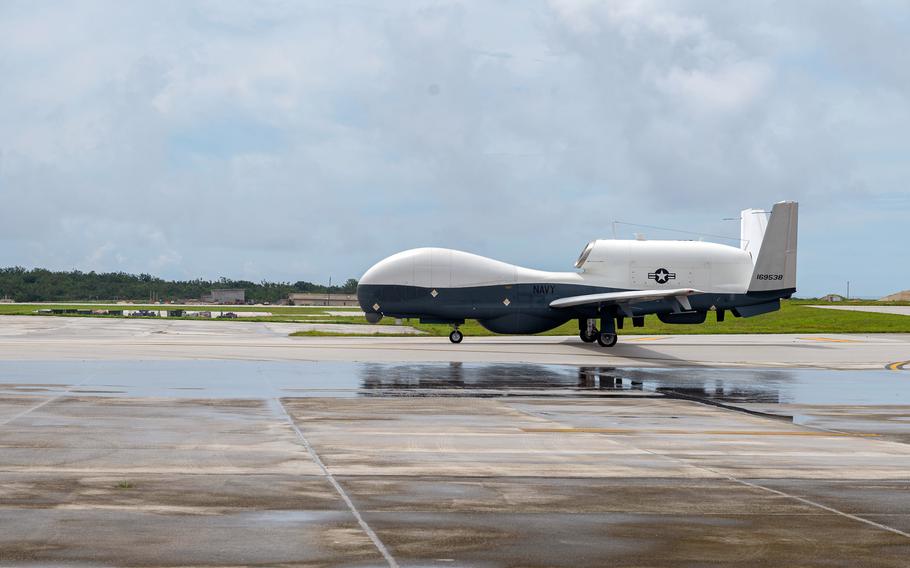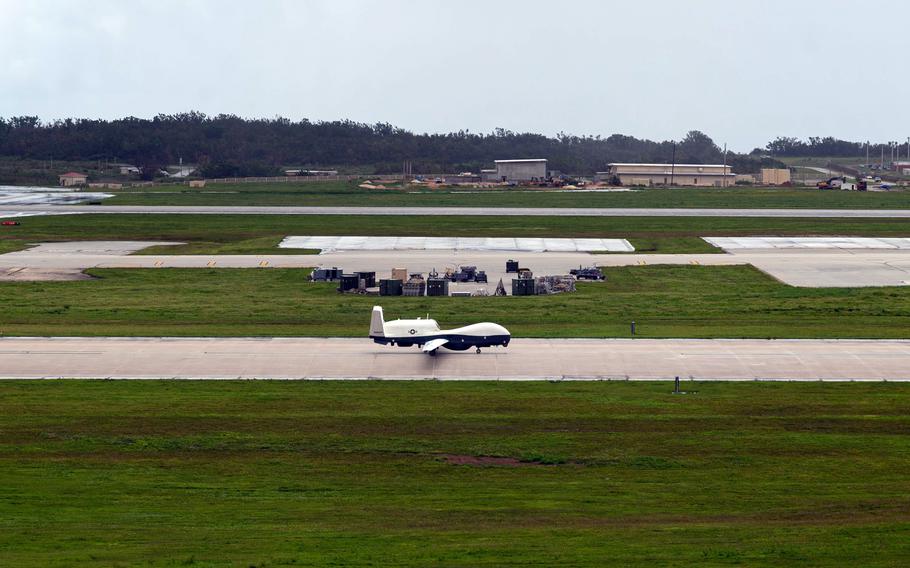
The Navy’s newest surveillance drone, the MQ-4C Triton, taxis at Andersen Air Force Base, Guam, Aug. 4, 2023. (U.S. Navy)
The Navy’s newest surveillance drone, the MQ-4C Triton, is back on Guam with further improvements and Navy approval to begin operations as it eases into the fleet.
Unmanned Patrol Squadron 19 out of Naval Air Station Jacksonville, Fla., returned to Andersen Air Force Base on Sept. 9 to further refine “MQ-4C tactics, techniques and procedures” and operate in the Indo-Pacific region, Naval Air Forces said in a news release Thursday.
The Triton returned to Guam with a declaration of initial operating capability, according to a news release Thursday from its manufacturer, Northrop Grumman Corp.
Initial operating capability means the squadron may put the MQ-4C to work and has qualified personnel to maintain it. It’s a level higher than early operational capability, a narrower development stage. The third step is full operational capability, meaning all units scheduled to receive the system have received it.
“Now that the system has achieved initial operating capability, commanders will be able to fully leverage Triton’s powerful sensor suite to detect and deter potential adversaries around the world,” Rho Cauley Bruner, director of Northrop’s Triton program, said in the company’s news release.

The Navy’s newest surveillance drone, the MQ-4C Triton, taxis at Andersen Air Force Base, Guam, Aug. 4, 2023. (U.S. Navy)
A Triton assigned to the squadron took its first flight under the new designation at Andersen on Aug. 18, according to Naval Air Forces.
Northrop thus far has delivered five Tritons to the Navy, the latest in June 2023, according to the release. The Navy trimmed its Triton order in May from 70 to 27, and reduced its deployable locations, or “orbits,” from five to three, according to a May report by Seapower magazine that cited an unidentified Navy spokesperson in May.
The squadron last deployed to Guam between January 2020 and October 2022. Since then, the Triton has been upgraded with a new sensor suite and other improvements, according to the Navy.
“Leveraging all the lessons we learned from our first deployment to Guam, Triton is poised to bring significant improvements that will increase its effectiveness in the battlespace, enabling our manned-unmanned team to maintain awareness in the maritime domain,” Rear Adm. Adam Kijek, commander of the Patrol and Reconnaissance Group, said in the news release.
Spokespeople for Andersen and U.S. Indo-Pacific Command did not immediately respond to requests for comments by Friday afternoon.
Northrop has received more than $600 million in Navy contracts to produce and modify the Triton since 2017. Each Triton costs $32.8 million to support and operate per year over a 20-year lifespan, according to a December 2021 Navy acquisition report.
Designed for both the Navy and the Royal Australian Air Force, the Triton is a multi-mission drone with an operating altitude of 50,000 feet and a 24-hour endurance, according to Northrop. It is particularly suited for maritime patrol, surveillance, communications and search-and-rescue operations.